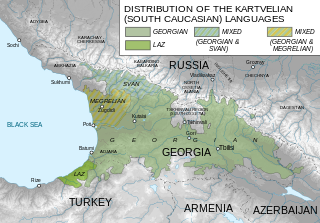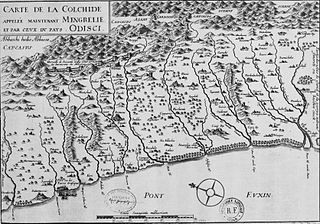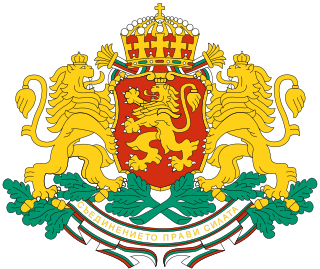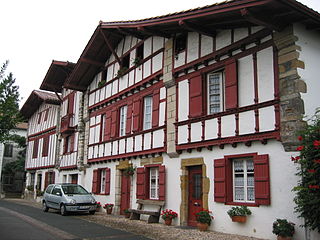
A Georgian name (Georgian :ქართული გვარ-სახელი, romanized:kartuli gvar-sakheli) consists of a given name and a surname used by ethnic Georgians. [1]

A Georgian name (Georgian :ქართული გვარ-სახელი, romanized:kartuli gvar-sakheli) consists of a given name and a surname used by ethnic Georgians. [1]
According to the Public Service Hall the most common Georgian names are: [2]
Males: Giorgi, Davit, Zurab, Levan, Aleksandre, Irakli, Mikheil, Tamaz, Nikoloz and Avtandil.
Females: Nino, Tamar, Mariam, Maia, Nana, Ketevan, Natela, Manana, Natia, Eka and Ana.
Georgian surnames are derived either from patronymics or, less frequently, from toponyms, with addition of various suffixes.
Georgian suffixes vary by region. The most common Georgian suffixes are:
The first recorded Georgian surnames date to the 7th–8th century. They were mostly toponymic in nature (such as Surameli, Machabeli etc.), patronymic, or derived from the profession, social status, position, or title, which was hereditary in the family (such as Amilakhvari, Amirejibi, Eristavi etc.). Beginning from the 13th century, the surnames became more frequently based upon patronymics, a tradition which became almost universal in the 17th–18th century. Some of the Georgian surnames indicate ethnicity or regional origin of the family, and are also generated as patronymics. Examples are Kartvelishvili ("child of Kartveli", i.e., Georgian), Megrelishvili ("child of Megreli", i.e., Mingrelian), Cherkezishvili ("child of Cherkezi", i.e., Circassian), Abkhazishvili ("child of Abkhazi", i.e., Abkhazian), Somkhishvili ("child of Somekhi", i.e., Armenian), Berdzenishvili ("child of Berdzeni", i.e., Greek), Prangishvili ("child of Prangi", i.e., French).
There are some very rare Georgian surnames like Jolbordi, Galogre, Lapachi, Molodini, Shermadini, Sivsive, Megvinetukhutsesi etc.
According to the Public Service Hall the most common Georgian surnames are: [4] Beridze, Kapanadze, Gelashvili, Maisuradze, Giorgadze, Lomidze, Tsiklauri, Bolkvadze, Kvaratskhelia and Nozadze.
Surname conventions and laws vary around the world. This article gives an overview of surnames around the world.
A patronymic, or patronym, is a component of a personal name based on the given name of one's father, grandfather, or an earlier male ancestor. It is the male equivalent of a matronymic.

A surname, family name, or last name is the mostly hereditary portion of one's personal name that indicates one's family. It is typically combined with a given name to form the full name of a person, although several given names and surnames are possible in the full name. In modern times the "hereditary" requirement is a traditional, although common, interpretation, since in most countries a person has a right for a name change.

Georgian is the most widely spoken Kartvelian language; it serves as the literary language or lingua franca for speakers of related languages. It is the official language of Georgia and the native or primary language of 88% of its population. Its speakers today amount to approximately 3.8 million. Georgian is written with its own unique Georgian scripts, alphabetical systems of unclear origin.

A personal name, full name or prosoponym is the set of names by which an individual person or animal is known, and that can be recited as a word-group, with the understanding that, taken together, they all relate to that one individual. In many cultures, the term is synonymous with the birth name or legal name of the individual. In linguistic classification, personal names are studied within a specific onomastic discipline, called anthroponymy. As of 2023, aside from humans, dolphins and elephants have been known to use personal names.

The Georgians, or Kartvelians, are a nation and Caucasian ethnic group native to present-day Georgia and surrounding areas historically associated with the Georgian kingdoms. Significant Georgian diaspora communities are also present throughout Russia, Turkey, Greece, Iran, Ukraine, the United States, and the European Union.

Mingrelian, or Megrelian is a Kartvelian language spoken in Western Georgia, primarily by the Mingrelians. Mingrelian has historically been only a regional language within the boundaries of historical Georgian states and then modern Georgia, and the number of younger people speaking it has decreased substantially, with UNESCO designating it as a "definitely endangered language".

Eastern Slavic naming customs are the traditional way of identifying a person's family name, given name, and patronymic name in East Slavic cultures in Russia and some countries formerly part of the Russian Empire and the Soviet Union.

Odishi was a historical district in western Georgia, the core fiefdom of the former Principality of Mingrelia, with which the name "Odishi" was frequently coterminous. Since the early 19th century, this toponym has been supplanted by Mingrelia (Samegrelo).
Indonesian names and naming customs reflect the multicultural and multilingual nature of the over 17,000 islands in the Indonesian archipelago. The world's fourth most populous country, Indonesia is home to more than 1,300 ethnic groups, each with their own culture, custom, and language. The Javanese are the largest single group, comprising around 40 percent of Indonesia's total population.

The Mingrelians are an indigenous Kartvelian-speaking ethnic subgroup of Georgians that mostly live in the Samegrelo-Zemo Svaneti region of Georgia. They also live in considerable numbers in Abkhazia and Tbilisi. In the pre-1930 Soviet census, the Mingrelians were afforded their own ethnic group category, alongside many other ethnic subgroups of Georgians.
Mongolian names have undergone a number of changes in the history of Mongolia, both with regard to their meaning and their source languages. In Inner Mongolia, naming customs are now similar to Mongolia but with some differences.

The Bulgarian name system has considerable similarities with most other European name systems, and with those of other Slavic peoples such as the Russian name system, although it has certain unique features.
An Armenian name comprises a given name and a surname. In Armenia, patronymics, which go between the first and last name, are also used in official documents.
This article features the naming culture of personal names of ethnic Serbs and the Serbian language. Serbian names are rendered in the "Western name order" with the surname placed after the given name. "Eastern name order" may be used when multiple names appear in a sorted list, particularly in official notes and legal documents when the last name is capitalized.
In Finland, a person must have a surname and at least one given name with up to four given names permitted. Surnames are inherited either patrilineally or matrilineally, while given names are usually chosen by a person's parents. Finnish names come from a variety of dissimilar traditions that were consolidated only in the early 20th century. The first national act on names came into force in 1921, and it made surnames mandatory. Between 1930 and 1985, the Western Finnish tradition whereby a married woman took her husband's surname was mandatory. Previously in Eastern Finland, this was not necessarily the case. On 1 January 2019, the reformed Act on Forenames and Surnames came into force.
Heritable family names were generally adopted rather late within Scandinavia. Nobility were the first to take names that would be passed on from one generation to the next. Later, clergy, artisans and merchants in cities took heritable names. Family names (surnames) were still used together with primary patronyms, which were used by all social classes. This meant that most families until modern times did not have surnames. Scandinavian patronyms were generally derived from the father's given name with the addition of a suffix meaning 'son' or 'daughter' or by occupation like Møller - naming tradition remained commonly used throughout the Scandinavian countries during the time of surname formation. Forms of the patronymic suffixes include: -son, -sen, -fen, -søn, -ler, -zen, -zon/zoon, and -sson,'datter'.

Basque surnames are surnames with Basque-language origins or a long, identifiable tradition in the Basque Country. They can be divided into two main types, patronymic and non-patronymic.
By the 18th century almost all Ukrainians had family names. Most Ukrainian surnames are formed by adding possessive and other suffixes to given names, place names, professions and other words.
Bediani was a medieval title, or a territorial epithet, of the Dadiani, the ruling family of Mingrelia in western Georgia, derived from the canton of Bedia, in Abkhazia, and in use from the end of the 12th century into the 15th. Bediani was occasionally used as a praenomen. The extent of the fief of Bedia is difficult to define; by the latter half of the 17th century, the Shervashidze of Abkhazia had supplanted the Dadiani in that area.